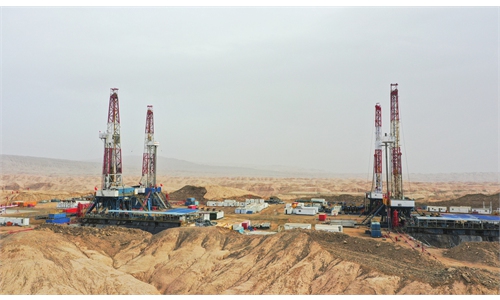
Temperature anomaly from November 5 to December 4, 2024 Photo: China Meteorological Administration
China's average temperature in November hit a record high since 1961, standing nearly 2 C above the historical norm, said the China Meteorological Administration (CMA) on Thursday.The CMA held a press conference to present the weather and climate characteristics of November, the climate trend forecast for December and release a bulletin for the China's greenhouse gas emissions in 2023, as reported by China Central Television (CCTV).
Jia Xiaolong, a deputy head of the National Climate Center, said during the press conference that the average temperature in November reached its highest level since 1961, approximately 2 C above the historical norm. Despite two strong cold air events, their frequency was lower than usual, resulting in significant temperature fluctuations.
In terms of precipitation, the country experienced above-average rainfall, with daily precipitation records for November broken in many areas. Heavy snowstorms occurred in parts of Northeast China and Inner Mongolia Autonomous Region, with localized snowfall breaking historical records, Jia said.
Meanwhile, typhoon activities were unusually active, with four typhoons forming in November, 1.9 times more than average, compared with the same period in previous years, according to the conference. Meteorological droughts emerged and developed periodically in regions including western parts of southern China, while other areas experienced moderate to severe drought conditions.
Frequent cold air movements are expected in December, with significant temperature fluctuations across most of the country, said Jia. Temperatures in regions including most of Northeast China and Southeast China are predicted to be lower than usual, while other areas will see temperatures near or above the historical norm. Precipitation will be concentrated in the Northeast and Southwest regions, with below-average rainfall expected in East and Central China.
Three major meteorological risks are highlighted for December, according to the report. Frequent cold air events may lead to low temperatures, strong winds and rain-snow freezing disasters, potentially impacting agriculture, transportation and energy sectors, requiring proactive prevention.
Also, areas with below-average rainfall should enhance forest fire prevention as drought conditions may worsen in some regions. Lastly, during cold air intermissions, air pollution may occur in parts of northern China. Therefore, it is suggested that monitoring is enhanced.
The China Greenhouse Gas Bulletin 2023 was also released during the conference, which marks the 13th consecutive year that the CMA has published China's greenhouse gas monitoring data, according to The Paper.
Observations from the Waliguan Baseline Observatory showed that the annual average concentration of carbon dioxide in 2023 is consistent with the global average growth rate. Concentrations of methane and nitrous oxide also showed increasing trends, although their growth rates were slightly lower than the global average.
According to The Paper, under the framework of the World Meteorological Organization, the CMA is responsible for high-precision greenhouse gas monitoring in China, employing internationally aligned methods, standards and procedures. A comprehensive high-precision greenhouse gas observation network has been established nationwide.
Moreover, China's Zhongshan National Atmospheric Background Station in Antarctica will conduct continuous and long-term operational observations of the concentration changes in Antarctic atmospheric components, and present its findings of the average state of the atmospheric composition and related characteristics in the region, according to the China Meteorological Administration, as reported by the Xinhua News Agency.
The CMA, as a scientific and foundational support department in addressing climate change, plays an increasingly important role in greenhouse gas monitoring, according to the conference. In the future, the CMA will accelerate the construction of a greenhouse gas observation network covering major cities and regions, strengthen dynamic analyses, and provide robust data support for China's carbon peak and carbon neutrality goals.
Global Times



